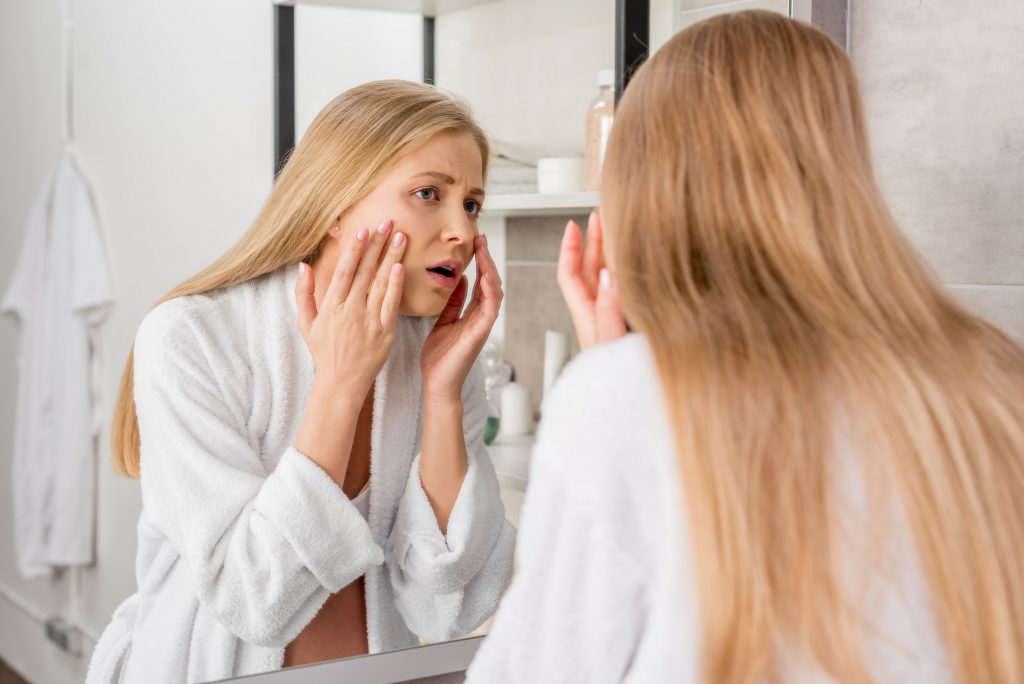Revising your skin care routine is not the first thing you may think of when learning you are pregnant, but pregnancy may require adjustments to your beauty routine.
Switching to an oil free cleaner
During pregnancy many women find that their complexion glows. A brighter dewier complexion (often referred to as pregnancy glow) is the result of rising hormone levels that cause facial glands to produce more oil and a dramatic increase in blood flow, leading to better circulation.
Not every woman experiences positive skin changes from the increased oil production. For some women, this heightened production can lead to pregnancy acne and a need to alter beauty routines. If acne becomes a problem during pregnancy you may benefit from switching to an oil-free cleanser and using non-comedogenic makeup. Be sure to discuss the use of any acne medication with your doctor.
Being vigilant about sunscreen
The heightened levels of hormones during pregnancy may also result in a change in skin pigmentation, known as melasma or commonly referred to as the mask of pregnancy. Melasma manifests as brownish spots or discoloration of the skin. While melasma can happen to any pregnant woman, it is more common in women with darker skin. The discoloration usually fades after your baby is born, but it has been known to return with sun exposure. Wearing sunscreen that is at least SPF 30 both during and after pregnancy is a smart idea.
Most sunscreens are considered safe during pregnancy, but products that use zinc oxide and titanium dioxide may be the safest since these sunblocks are not absorbed by the skin. It’s also advisable to wear sunglasses and a hat.
Talk to your doctor about retinoids
Oral retinoids such as isotretinoin are prescription medications used to treat acne or plaque psoriasis, but they are not considered safe for use during pregnancy. They increase the risk of birth defects, as well as raising the risk of miscarriage and premature birth. If you are taking a prescription medication with retinoids, talk to your doctor right away. Retinoids are also found in anti-aging moisturizers, since they help to renew skin by speeding up cell division. While the amount of retinol absorbed via skin cream is low, use during pregnancy remains controversial as birth defects have been associated with retinoid use. It’s best to avoid products that contain Retin-A, Retinol or Retinoic acid.
Read the ingredients on your cleansers
Cleansers, toners and exfoliants often use alpha hydroxy acid (AHA) and beta hydroxy acid (BHA). Two common AHAs found in cleansers and toners are glycolic acid and lactic acid. Only small amounts are absorbed into the skin, so they are considered low risk when used in skin treatments. Not much research into their safety during pregnancy has been done, so women are advised to limit use to small amounts.
Salicylic acid, an active ingredient in aspirin, is a BHA and a key ingredient in anti-acne products. Studies have not shown aspirin to cause birth defects in humans, but aspirin has been shown to cause birth defects in animals. While less BHA is absorbed via the skin, doctors advise minimizing use during pregnancy. Two percent salicylic acid is considered a safe level in a cleanser. Using a toner once or twice a day is considered safe, but if you’re considering a face or body peel that may use more salicylic acid, discuss it first with a dermatologist.
Oral retinoids such as isotretinoin are prescription medications used to treat acne or plaque psoriasis, but they are not considered safe for use during pregnancy. They increase the risk of birth defects, as well as raising the risk of miscarriage and premature birth.
Using soy can have side effects
A product using natural ingredients is not necessarily a smarter option during pregnancy. One example is soy-based beauty products. While soy products are used to lighten skin coloration, they also affect estrogen levels and may worsen melasma during pregnancy. The composition of the soy-based products matters, so discuss all use with your doctor. Oil of bergamot is another natural ingredient that can worsen melasma.
Gel manicures
Gel manicures have become popular because they last longer than normal manicures, but they involve potentially harmful chemicals, the most worrisome of which is formaldehyde. Working with formaldehyde has been shown to cause miscarriage and fertility problems. While occasional use—such as getting manicures—has not been shown to increase risks, it’s considered best to limit exposure or to use a nail polish formulated to exclude formaldehyde.
Acetone is another chemical associated with gel manicures and long term use has also been associated with health risks. Removing gel nail polish often requires soaking fingertips in acetone for up to 20 minutes. Using nail polish remover every day is still considered safe, but if you’re worried, you can use acetone-free polish removers at home or bring these removers to the salon.
If you do get your nails done in a salon, be sure the salon is well ventilated. Wash your hands thoroughly after a manicure to remove any chemicals from your skin.

New sensitivities
Some women’s skin is extra sensitive during pregnancy so beauty products that were fine before pregnancy may now irritate the skin. If you are trying a new product always test it on a small area before applying to a larger section of your face or body.
Most skin care products and makeup are considered safe to use, unless they contain retinoids or salicylic acids. Over the counter steroid creams to treat eczema or psoriasis are generally safe to use, but always discuss any stronger steroid use with your doctor.

